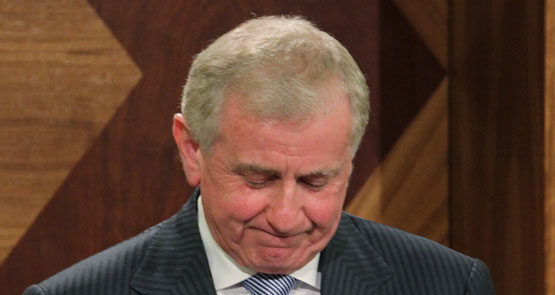
Following former Rudd-Gillard minister Stephen Smith’s failed attempt to topple Mark McGowan as Labor leader in Western Australia, a headline in The Australian Financial Review asked, “Has Stephen Smith staged Australia’s most embarrassing leadership challenge?”
Here’s some of the competition:
1. Tim Mander, Queensland, 2016
Since the shock defeat of the Newman government last year, Queensland’s Liberal National Party has once again been under the leadership of three-time loser Lawrence Springborg, but many feel he’s just keeping the seat warm. Last month, a grouping of religious-right agitators sought to get things moving by drumming up support for the party’s education spokesman, Tim Mander. However, they were forced to back down after struggling to make it to double figures out of a party room of 42. As an LNP source with a genius for mixed metaphors put it to The Australian, the plot was “a case of political premature ejaculation, and it’s backfired”.
2. Simon Crean, federal, 2013
One episode among many in federal Labor’s leadership war of 2010 to 2013 was Simon Crean’s bid to initiate a spill motion against Julia Gillard in March 2013, putting his own name forward for deputy. The idea was that Kevin Rudd would be shamed into laying his cards on the table, but it wasn’t to be; Crean sacrificed his position in cabinet without result, and Gillard lived to fight another 97 days.
3. Willem Westra van Holthe, Northern Territory, 2015
Late one evening in February last year, Northern Territory MP Willem Westra van Holthe announced he had deposed Adam Giles as leader of the Country Liberal Party, and would be sworn in as chief minister the following morning. However, just 18 hours later, Westra van Holthe stood before the cameras with Giles to offer him his full support, describing the remarkable events of the previous night as “nothing more than a fairly large blip on the radar”. In the interim, Giles had locked his supporters in behind a plan to cross the floor and bring down the government if Westra van Holthe emerged at its head. Giles has since remained in the job despite his demonstrated lack of support from most of his colleagues, and is set to lead his crippled government to an election on August 27.
4. Ben Wyatt, Western Australia, 2011
After losing office in 2008, Labor in Western Australia had a spell under the amiable but low-impact leadership of Eric Ripper, which was never thought likely to last. In January 2011, his shadow treasurer, Ben Wyatt, emerged from a Right faction meeting believing he had won its support to topple Ripper. It turned out he was wrong, as powerful Shop Distributive and Allied Employees’ Association figurehead Joe Bullock remained committed to Ripper. The challenge promptly fell apart, and Wyatt was stripped of the Treasury portfolio. He recovered it when Mark McGowan ousted Ripper a year later, and has been one of the main bricks in the wall that Stephen Smith has run into over the past few days.
5. Joh Bjelke-Petersen, federal, 1987
Joh Bjelke-Petersen, aged 76 and in his 18th year as Queensland premier, planned to crash his way into the prime ministership at the 1987 election by fielding his own candidates, and winning enough seats to dominate a fractious conservative majority. However, he was well short of having the necessary infrastructure in place when Bob Hawke announced a July double dissolution election, and succeeded only in torpedoing John Howard’s first bid for the prime ministership.








Re the ousting of the LNP and Campbell Neumann… It was not a ‘shock defeat’, it was a well deserved kick in the rear for a secretive and nasty mob who didn’t care what anyone thought, other than the big end of town.
The Crean challenge differs from the others in that he had a strategy that did not necessarily depend on winning. Knowing his political career was pretty much over, he sacrificed himself in an effort to remove the terminally unpopular Gillard. It is possible his challenge laid the groundwork for the change 3 months later.